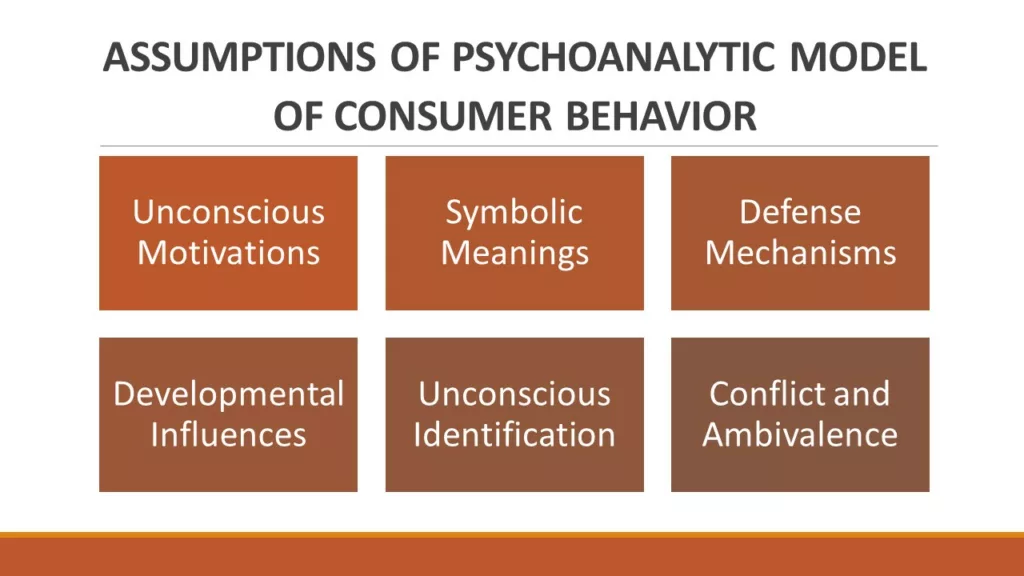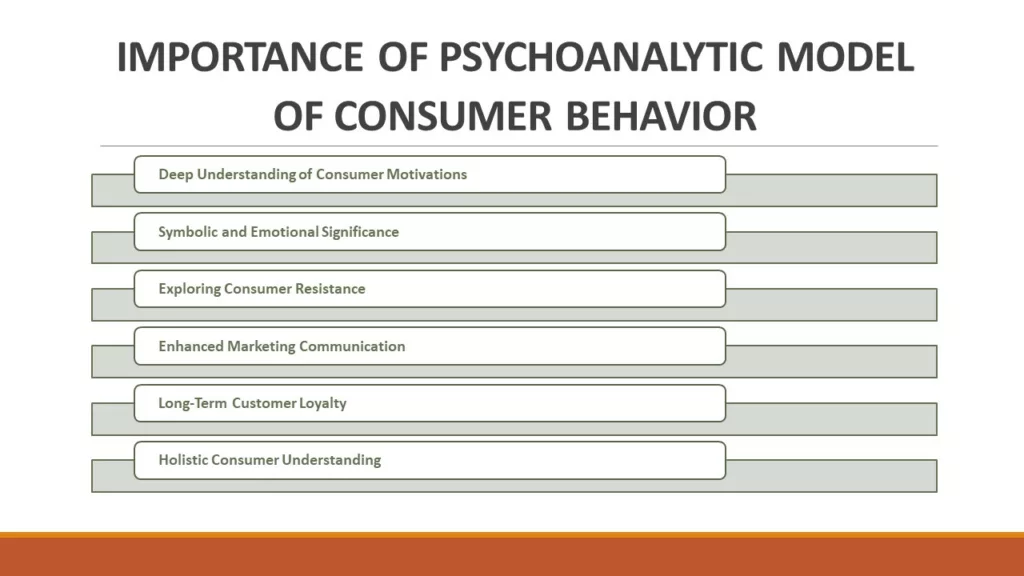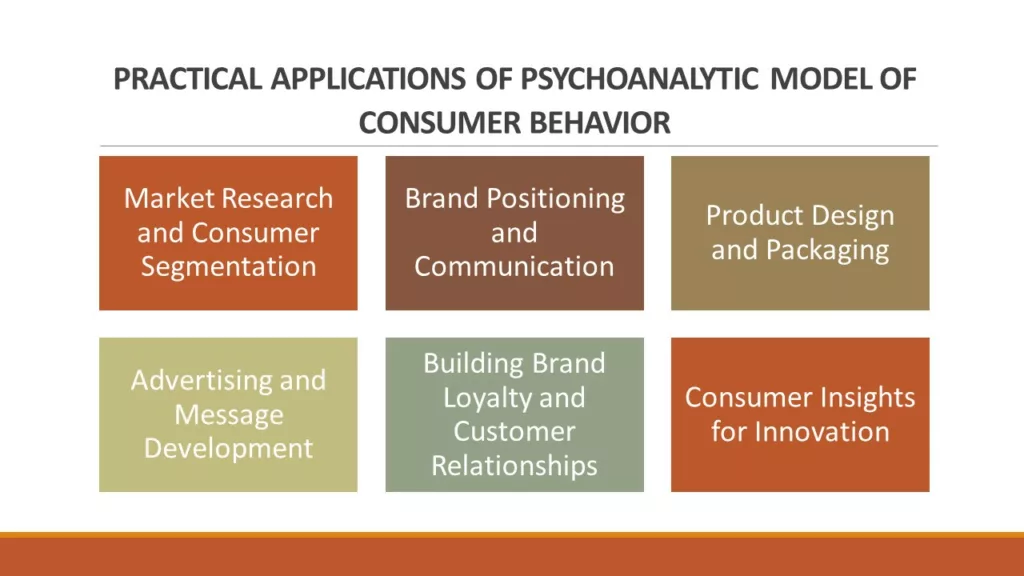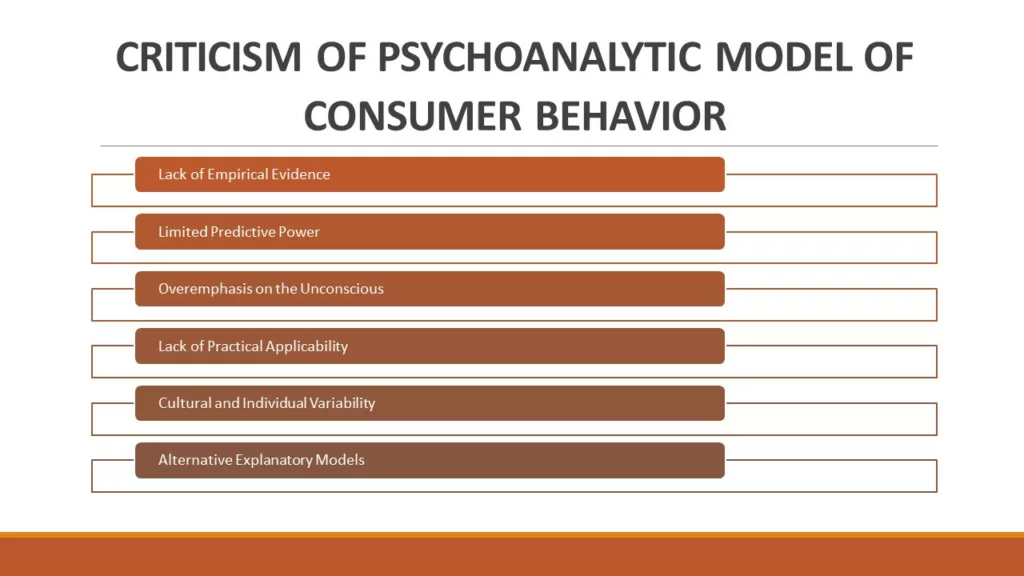PSYCHOANALYTIC MODEL OF CONSUMER BEHAVIOR
The psychoanalytic model of consumer behavior offers a unique perspective on understanding why individuals make certain purchasing decisions. Rooted in the theories of Sigmund Freud and his followers, this model delves into the unconscious motivations, desires, and conflicts that drive consumer choices. It suggests that consumer behavior is not solely rational and logical but is also influenced by unconscious needs, childhood experiences, and emotional factors. By examining the interplay between conscious and unconscious processes, the psychoanalytic model seeks to shed light on the complex psychological dynamics that shape consumer behavior. This introductory paragraph will explore the fundamental concepts of the psychoanalytic model and highlight its significance in unraveling the mysteries of consumer decision-making.
ASSUMPTIONS OF PSYCHOANALYTIC MODEL OF CONSUMER BEHAVIOR
The psychoanalytic model of consumer behavior is based on several key assumptions that provide the foundation for understanding consumer motivations and behavior. These assumptions include:

- Unconscious Motivation: The psychoanalytic model assumes that consumer behavior is driven by unconscious motivations and desires. These unconscious forces may stem from unresolved conflicts, repressed memories, or unfulfilled needs from early childhood experiences. These underlying motivations influence consumer choices and can be difficult for individuals to articulate or recognize consciously.
- Symbolic Meaning: The model emphasizes the symbolic meaning attached to products and brands. It suggests that consumers often assign symbolic value to products, projecting their own desires, aspirations, and identity onto them. Products and brands can serve as symbolic substitutes or representations of unconscious desires, allowing individuals to express and satisfy those desires indirectly.
- Defense Mechanisms: Psychoanalytic theory proposes that individuals employ defense mechanisms to protect themselves from anxiety and emotional distress. In the context of consumer behavior, defense mechanisms can manifest in various ways, such as rationalization, denial, or displacement. Consumers may justify their purchases or use shopping as a way to alleviate emotional tension or fulfill unmet Unconscious Motivations needs.
- Developmental Influences: The psychoanalytic model considers the influence of early developmental experiences on consumer behavior. Childhood experiences, particularly during the formative stages, can shape an individual’s attitudes, preferences, and desires. The model suggests that unresolved conflicts or traumas from childhood may be reflected in consumer choices later in life.
- Unconscious Identification: The model highlights the role of unconscious identification, whereby individuals identify with certain products, brands, or celebrity figures on an unconscious level. This identification allows consumers to integrate desired attributes or qualities associated with those entities into their own self-concept, providing a sense of fulfillment or gratification.
- Conflict and Ambivalence: The psychoanalytic model acknowledges the presence of internal conflicts and ambivalence in consumer decision-making. Individuals may experience conflicting desires or emotions when making purchase decisions, reflecting the dynamic interplay between conscious and unconscious motivations. This conflict can lead to impulsive or contradictory buying behaviors.
By considering these assumptions, the psychoanalytic model of consumer behavior offers a rich framework for understanding the complex and multifaceted nature of consumer decision-making, going beyond rational economic factors to delve into the underlying psychological dynamics at play.
IMPORTANCE OF PSYCHOANALYTIC MODEL OF CONSUMER BEHAVIOR
The psychoanalytic model of consumer behavior holds significant importance in the field of marketing and consumer research for several reasons:

- Deep Understanding of Consumer Motivations: The model provides a deeper understanding of consumer motivations by exploring the unconscious forces that drive behavior. By uncovering hidden desires, unresolved conflicts, and repressed emotions, marketers can gain insights into why consumers make certain choices and tailor their marketing strategies accordingly.
- Symbolic and Emotional Significance: The model recognizes the symbolic and emotional significance that products and brands hold for consumers. It highlights the role of symbolism, self-expression, and identity formation in consumer behavior. Understanding the symbolic meanings attributed to products helps marketers create meaningful and resonant brand messages that tap into consumers’ subconscious desires and aspirations.
- Exploring Consumer Resistance: The psychoanalytic model helps explain consumer resistance and reluctance to adopt certain products or messages. Unconscious conflicts and defense mechanisms can hinder consumer acceptance and engagement. By understanding these dynamics, marketers can address resistance more effectively and develop strategies to overcome barriers.
- Enhanced Marketing Communication: The model enables marketers to craft persuasive marketing communication that speaks to consumers’ unconscious motivations. By tapping into deep-seated desires and emotions, marketers can create compelling narratives, imagery, and messaging that resonate on a subconscious level and evoke emotional responses, leading to stronger brand connections and increased purchase intent.
- Long-Term Customer Loyalty: The psychoanalytic model recognizes the enduring influence of early experiences and childhood development on consumer behavior. By understanding these long-term influences, marketers can build strategies that foster long-term customer loyalty and brand attachment. Creating positive associations and emotional connections early in the consumer’s life can lead to lasting relationships with the brand.
- Holistic Consumer Understanding: By integrating the psychoanalytic model into consumer research, marketers can develop a more holistic understanding of consumers. This model acknowledges that consumers are not purely rational decision-makers but are influenced by complex psychological processes. This understanding goes beyond demographic and behavioral segmentation, allowing marketers to develop more nuanced and targeted marketing strategies.
Overall, the psychoanalytic model of consumer behavior enriches our understanding of consumer motivations, decision-making processes, and emotional connections with brands. By delving into the unconscious factors that shape behavior, marketers can create more impactful strategies that resonate with consumers on a deeper level, leading to increased customer satisfaction, loyalty, and business success.
PRACTICAL APPLICATIONS OF PSYCHOANALYTIC MODEL OF CONSUMER BEHAVIOR
The psychoanalytic model of consumer behavior offers several practical applications that can assist marketers in understanding and influencing consumer behavior. Here are some key practical applications of this model:

- Market Research and Consumer Segmentation: The psychoanalytic model can inform market research efforts by uncovering deep-seated motivations and desires that drive consumer behavior. By conducting qualitative research methods such as in-depth interviews or projective techniques, marketers can gain insights into consumers’ unconscious needs and preferences. This information can then be used to develop more nuanced consumer segments based on psychological profiles, enabling targeted marketing strategies.
- Brand Positioning and Communication: Understanding the symbolic meanings and emotional associations consumers attach to brands is crucial for effective brand positioning. The psychoanalytic model helps marketers develop brand personalities and communication strategies that resonate with consumers’ unconscious desires and aspirations. By aligning brand attributes with consumers’ underlying motivations, marketers can create compelling narratives and imagery that forge emotional connections and differentiate their brands from competitors.
- Product Design and Packaging: The psychoanalytic model can guide product design and packaging decisions by considering consumers’ unconscious desires and preferences. By understanding the symbolic value consumers assign to products, marketers can design products and packaging that align with these unconscious associations. This approach can enhance product attractiveness, increase purchase intent, and foster positive emotional experiences.
- Advertising and Message Development: The psychoanalytic model can be applied to develop persuasive advertising messages that appeal to consumers’ unconscious motivations. By tapping into consumers’ emotional needs, marketers can create compelling narratives, use imagery and metaphors that resonate with their desires, and engage consumers on an emotional level. This approach can result in more memorable and impactful advertising campaigns.
- Building Brand Loyalty and Customer Relationships: The psychoanalytic model helps marketers establish strong brand loyalty and customer relationships by understanding consumers’ long-term psychological influences. By considering consumers’ early developmental experiences and the impact of childhood memories and associations, marketers can create brand experiences that evoke positive emotions and build lasting connections with consumers. This approach can lead to increased customer satisfaction, repeat purchases, and brand advocacy.
- Consumer Insights for Innovation: The psychoanalytic model can provide valuable insights for product and service innovation. By uncovering consumers’ unmet psychological needs, desires, and conflicts, marketers can identify opportunities for new product development or enhancements. Understanding the underlying motivations can guide the innovation process and lead to the creation of products and services that fulfill consumers’ deep-seated desires.
In summary, the psychoanalytic model of consumer behavior offers practical applications in market research, brand positioning, product design, advertising, customer relationship management, and innovation. By incorporating these insights into marketing strategies, organizations can better understand and influence consumer behavior, ultimately leading to more effective marketing campaigns and enhanced customer satisfaction.
CRITICISM OF PSYCHOANALYTIC MODEL OF CONSUMER BEHAVIOR
While the psychoanalytic model of consumer behavior offers valuable insights into the psychological dynamics underlying consumer decision-making, it has also faced criticism. Some of the key criticisms of the psychoanalytic model include:

- Lack of Empirical Evidence: Critics argue that the psychoanalytic model lacks sufficient empirical evidence to support its claims. Much of the model is based on subjective interpretations and case studies, making it difficult to generalize findings or establish a solid scientific foundation. The model’s reliance on unconscious processes and subjective interpretations has led some to view it as speculative and lacking in empirical rigor.
- Limited Predictive Power: The psychoanalytic model has been criticized for its limited predictive power. Critics argue that the model’s emphasis on unconscious motivations and symbolic meanings makes it challenging to develop concrete predictions or testable hypotheses. The model’s complexity and reliance on individual interpretation make it difficult to apply consistently across different consumer contexts.
- Overemphasis on the Unconscious: Some critics contend that the psychoanalytic model places excessive emphasis on the unconscious and neglects the role of conscious processes and external influences in consumer behavior. They argue that consumers are often rational decision-makers who consider practical factors such as price, quality, and functionality when making purchasing decisions. The model’s exclusive focus on unconscious motivations may downplay the importance of conscious cognitive processes and external environmental factors.
- Lack of Practical Applicability: Critics suggest that the psychoanalytic model may have limited practical applicability in real-world marketing situations. Its complex and abstract nature can make it challenging for marketers to translate the model’s insights into actionable strategies. The model’s reliance on in-depth psychological analysis may not always align with the time and resource constraints faced by marketers in developing and implementing marketing campaigns.
- Cultural and Individual Variability: The psychoanalytic model has been criticized for its limited consideration of cultural and individual variability in consumer behavior. Critics argue that consumer behavior is influenced by social, cultural, and economic factors that may override or modify unconscious motivations. The model’s emphasis on individual unconscious processes may not adequately account for the collective and contextual influences on consumer decision-making.
- Alternative Explanatory Models: Critics argue that alternative models, such as cognitive psychology, behavioral economics, and social psychology, provide more robust and empirically supported explanations of consumer behavior. These models focus on conscious cognitive processes, decision heuristics, and social influences, offering more practical and predictive frameworks for understanding consumer decision-making.
In conclusion, while the psychoanalytic model of consumer behavior offers valuable insights into the unconscious motivations and symbolic meanings that underlie consumer choices, it faces criticism for its limited empirical evidence, limited predictive power, overemphasis on the unconscious, lack of practical applicability, and limited consideration of cultural and individual variability. Critics argue that alternative models provide more robust and practical explanations of consumer behavior.